





You just bought a beautiful tree in a pot, and you have the perfect spot for it in your yard. What?s the best way to plant it? This step by step photo tutorial answers some common questions about planting trees.
You may have heard, "Dig a $100 hole for a $10 tree," and it's good advice. Extra time spent doing a good job of planting your new tree will pay off as the tree settles in and starts to grow strongly in its new home.When should you plant? Bare root trees are best planted in early spring, or when they are dormant. Potted trees, on the other hand, can be planted any time you can dig a hole in the ground. It's best not to dig when the ground is very wet, especially if you have heavy clay soil that will compact to form a watertight tomb around the rootball. If the ground is frozen or very dry, it may be so hard that you can barely make a dent in the surface, let alone a hole. Under any other conditions, you are good to go!
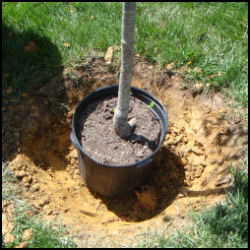 How big should you dig? The general rule of thumb is to dig a hole about twice the diameter of the pot. In poor soil, or with a particularly treasured specimen, I go for three times the diameter. The hole should be no deeper than the depth of the rootball, with sloping sides for good drainage. Before you start digging, double check the placement of your hole to be sure you've left enough space around your tree for its mature size.
How big should you dig? The general rule of thumb is to dig a hole about twice the diameter of the pot. In poor soil, or with a particularly treasured specimen, I go for three times the diameter. The hole should be no deeper than the depth of the rootball, with sloping sides for good drainage. Before you start digging, double check the placement of your hole to be sure you've left enough space around your tree for its mature size.
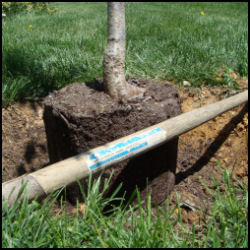 How deep should you plant the tree? It's often good to have a quarter to a third of the rootball above the level of the surrounding soil, especially if your soil doesn't drain especially well. In our heavy clay soil, we plant all trees above grade, and we mound soil up around them as we fill in the hole. Never plant the tree deeper than it was growing in its pot.
How deep should you plant the tree? It's often good to have a quarter to a third of the rootball above the level of the surrounding soil, especially if your soil doesn't drain especially well. In our heavy clay soil, we plant all trees above grade, and we mound soil up around them as we fill in the hole. Never plant the tree deeper than it was growing in its pot.
What if the potted tree is rootbound? With a rootbound tree, you'll see a solid mass of roots when you remove the pot, including roots that circle around the outside of the rootball. If you simply stick the rootball in the ground like that, the roots tend to continue growing around in the same shape rather than expanding out into the surrounding soil. If that happens, the tree can die. Loosening and untangling the circling roots so you can spread them out in the planting hole can save a rootbound tree. You can also make several vertical slices into the rootball, just an inch or so deep, to stop the roots from continuing to circle.
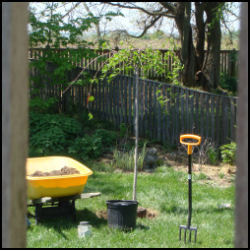 How should you position a tree? Carefully! Don't rush. Take a break after your digging, and have a cold drink while you consider the tree from various distances and viewing angles. Place the tree upright in the hole, with a helper to hold and turn it. Think about how its branch structure may look as the tree grows. Don't forget to look at it from up on the deck, or from an upstairs window. Think about whether a particular overhanging branch will be in the way, and turn the tree so that branch will grow in a better direction. You'll probably have this tree for a very long time, and this is your best opportunity to situate it exactly where you want it.
How should you position a tree? Carefully! Don't rush. Take a break after your digging, and have a cold drink while you consider the tree from various distances and viewing angles. Place the tree upright in the hole, with a helper to hold and turn it. Think about how its branch structure may look as the tree grows. Don't forget to look at it from up on the deck, or from an upstairs window. Think about whether a particular overhanging branch will be in the way, and turn the tree so that branch will grow in a better direction. You'll probably have this tree for a very long time, and this is your best opportunity to situate it exactly where you want it.
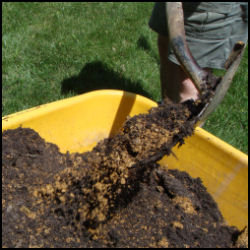 Should you amend the soil? Some say soil amendments help, and others say the tree needs to adapt to the native soil in your yard or it will never want to grow beyond its planting hole. The soil in our yard is pretty nasty clay. If I didn't amend it, I don't think our newly planted trees and shrubs would survive. I add 30-50% compost, bark fines, old potting mix, peat moss, or any other composted organic material I have on hand. I also add a handful of my favorite watering aid, polymer moisture crystals.
Should you amend the soil? Some say soil amendments help, and others say the tree needs to adapt to the native soil in your yard or it will never want to grow beyond its planting hole. The soil in our yard is pretty nasty clay. If I didn't amend it, I don't think our newly planted trees and shrubs would survive. I add 30-50% compost, bark fines, old potting mix, peat moss, or any other composted organic material I have on hand. I also add a handful of my favorite watering aid, polymer moisture crystals.
Should you fertilize? The answer to that may depend on the tree, but most seem to appreciate a dose of time release fertilizer in their planting hole. Watering in a newly planted tree with half strength water soluble fertilizer (such as Miracle GroTM) or an additive like SuperThriveTM can also give it an initial boost.
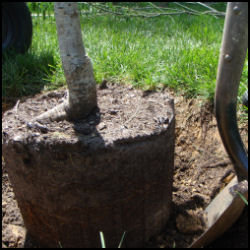 Should you stomp the soil into place? You could, but there's a better way. As you shovel the amended soil around the tree and into the hole, stop two or three times to water it in a little. Not only does this give your new tree a good drink, it's also a great way to settle the soil around the roots and to eliminate air pockets.
Should you stomp the soil into place? You could, but there's a better way. As you shovel the amended soil around the tree and into the hole, stop two or three times to water it in a little. Not only does this give your new tree a good drink, it's also a great way to settle the soil around the roots and to eliminate air pockets.
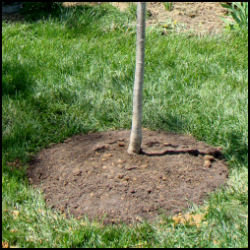 What about mulch? Yes! Several inches of landscape mulch will keep down weeds and hold in moisture. However, do pull the mulch back several inches from the trunk on all sides. Having organic mulch right up against the trunk can lead to pests and disease.
What about mulch? Yes! Several inches of landscape mulch will keep down weeds and hold in moisture. However, do pull the mulch back several inches from the trunk on all sides. Having organic mulch right up against the trunk can lead to pests and disease.
To stake, or not to stake? If you're not sure staking is needed to stabilize your new tree, stake it. Put one stake on each side of the tree, and run ropes from the stakes to the trunk. Use sections of tubing or old garden hose to protect the bark from chafing. Taut-line hitches allow easy adjustment without making the ropes overly tight. After a season or two, remove the ropes and the stakes. Don't leave the ropes around the tree, or they'll cut into the tree as it grows.
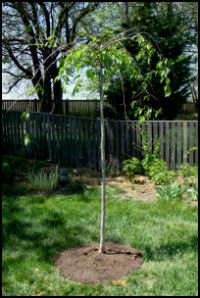 Take a little extra time to plan the placement of your tree, to dig it a nice hole, and to stake and mulch it after planting. The care you put into planting a young tree now will be repaid a thousand times over as the tree grows to become a prized feature of your landscape.
Take a little extra time to plan the placement of your tree, to dig it a nice hole, and to stake and mulch it after planting. The care you put into planting a young tree now will be repaid a thousand times over as the tree grows to become a prized feature of your landscape.
For more information, check out our Trees and Shrubs Discussion Forum. Your local agricultural extension service office should have additional information on selecting and planting trees best suited for your area and situation.
Photos by Jill M. Nicolaus.
Copyright © www.100flowers.win Botanic Garden All Rights Reserved